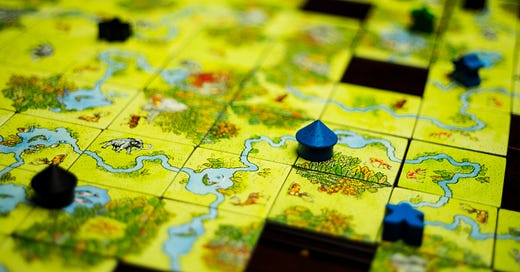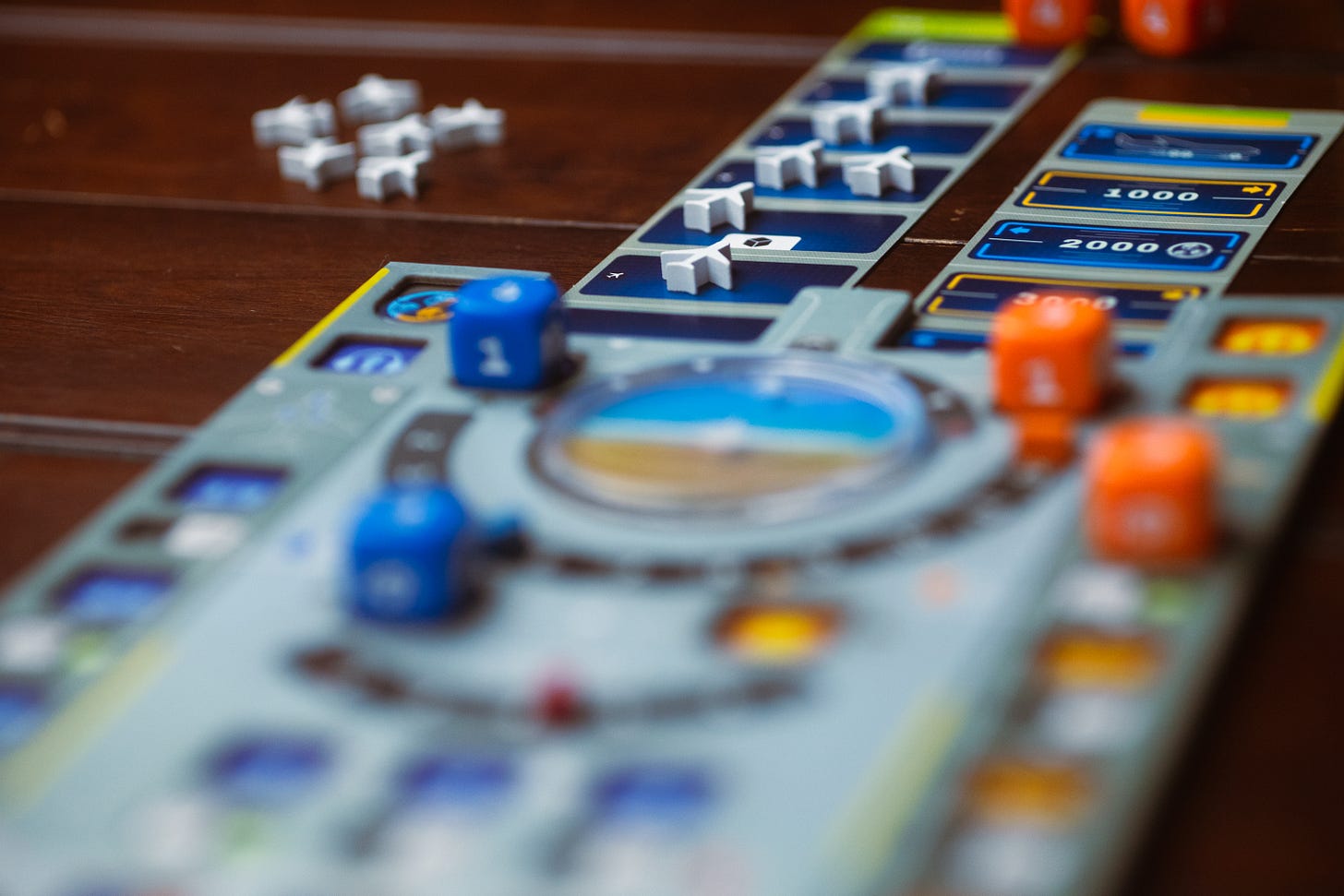Five great games on Board Game Arena, plus a discussion on U.S. tariffs
It's an awful week for publishers and players alike.
Hello, hello! It’s been a bit of a wild week for completely non-personal reasons (read: tariffs), which we’ll talk about shortly. I’ve also written about five games I’ve been enjoying on Board Game Arena — read into that connection in whatever way you’d like. Before we get there, though: I know this week seems a little heavy. It is, and I don’t think there’s any escaping that fact. While I usually aim to bring a bit of levity in my writing, this is a topic that will negatively impact publishers and players alike, and I think it’s important to at least give you some resources to read if you’d like.
Right — let’s get on with the show.
A word on U.S. tariffs
How do you write about board games after a week in which most publishers are rightly concerned about the future of their businesses and their abilities to publish games? It is thankfully not often that macroeconomics and board games intertwine outside of theme, but an escalating trade war with the United States and China does gamers no favors. (I don’t think it does anyone any favors generally, and this instance absolutely doesn’t.) With the overwhelming majority of game-producing factories situated in China, the impact will absolutely be felt far and wide just in this hobby. Of course, gaming is a hobby and not a pure necessity in the same way food and shelter are: Publishers and players will feel substantial negative impact, but we are hardly the only ones.
Rather than continue to pontificate, I’d instead point you to a few important pieces online. The specifics may well be out of date by the time you read this post, too.
Jamey Stegmaier, who runs the publisher Stonemaier Games, wrote two important pieces: The Darkest Timeline and The Math of Tariffs; both detail specifics from an industry perspective. Jamey is routinely the most transparent person in board games publishing.
(The) reality of a 54% tariff is devastating. There is no math that makes it work. There is no silver lining. It is a lose-lose-lose situation for everyone involved except the US government (which, in the long term, will also not benefit from the repercussions of the tariffs).
This piece from Ars Technica, Trump tariffs terrify board game designers, gathers quotes from a variety of designers and publishers.
Aftermath’s headline is grim — and accurate: Tariffs Are Going To Kill Board Gaming As We Know It
Daniel Newman, who runs the small publisher New Mill Games, wrote a Bluesky thread on Tuesday about why he can’t just switch to U.S.-based printing facilities, even though the facilities for printing card games are stronger here.
An interview with Cephalofair’s COO, Price Johnson: Do Not Pass Go, Do Not Collect $200, Do Go Out of Business
Finally, W. Eric Martin of BoardGameGeek: Tariff Talk from Publishers on Costs, Sales, Conventions, Projections, and More
There’s more out there if you want to read it. It’s difficult to imagine what the board games industry — or the world at large — looks like in a year should the facts of the matter stand or worsen — and worsening does appear to be the order of the day.
Five great games on Board Game Arena
If the cost of physical games is a near-lock to increase, perhaps we can take some small comfort in knowing that Board Game Arena remains a viable option for playing new games. I’ve been playing a nice little slew of new games there.
We’ll start with three two-player card games, each of which takes the climbing and shedding games in an interesting direction. They’ve all just been published by New Mill Industries and are available on their site now.
Lepidoptery takes ladder climbing and supplants it with a classic connect-four idea, and I’ll be darned, it works surprisingly well. One player will lead with a meld of their choice, picking from a run of 3, a run of 2, a single, a pair, or a triple. The other must follow with a higher-value meld. There are two important hooks to the game here. First, you can’t play the same meld type twice in a row without passing. Second, when you play a meld, you place a disc on a six-by-six grid with columns corresponding to each meld type, essentially dropping it in a column like it’s Connect Four. If you connect four of your discs, you win.
The BGA implementation is simple, and climbing games tend to work reasonably well asynchronously. The art’s a bit more engaging physically, where the beiges, teals and light reds tend to feel a bit more subtle than on the screen.
Lepidoptery has such cool ideas behind it, and it’s a great reminder that even as trick-taking and climbing-and-shedding games are released at an increasingly fast clip, there’s still interesting, fertile ground to be plowed. Designed by David Karesh and Srinivas Vasudevan, illustrated by Imogen Oh, and published by New Mill Industries.
Greasy Spoon, designed by the man behind such greats as Haggis (Ross ’10) and Bacon (’24), feels quite a bit more experimental than his two biggest hits, and that’s not a bad thing. In this two-player climbing game, you’re playing melds of three categories: Drinks are a single card, Sides are two cards, and Mains are three cards. You can also play Combinations, which combine either a Main and a Drink or a Main and a Side. Within Sides and Mains, there are four types of melds apiece. When following, you can only play a stronger meld within the given menu category.
The hook: When you pass, you may optionally discard up to three cards to your Backburner. Once you’ve played through all the cards in your deck, your Backburner becomes your new deck. Play through both to win. As a result, if you’re clever about it, you can discard some high-ranking menu items and combinations for later use — but if you’re not careful, you might torpedo your chances at playing cards at all. Designed by Sean Ross, illustrated by Carly A-F, and published by New Mill Industries.
Dickory features no suits, just cards ranked 1 through 12, and it features a queue of cards that’ll determine the highest-rank card for the trick. As an example, if the card at the right of the queue is a 7, then 7 is the highest ranked card for the trick, and 8 is the lowest. Make sense? It’s basically like a clock, but instead of the hands rotating, the numbers rotate. It’s probably the most unusual of the three here, and they’re all a bit unusual. It’s also the one I’ve played the least, so I don’t have that much to say about it just yet. Designed by Sean Ross and Hanibal Sonderegger, illustrated by Imogen Oh, and published by New Mill Industries.
Sky Team continues to be one of my all-time favorite cooperative games, and that they’ve added the expansion on Board Game Arena just makes it all the better. Sky Team: Turbulence offers some new scenarios, including some that see you only have access to two dice at a time and some that re-roll your dice before every turn you take. All this throws more roadblocks up against your ability to plan, which really just amplifies what the game’s already all about. Designed by Luc Rémond, illustrated by Eric Hibbeler and Adrien Rives, and published by Scorpion Masqué.
Carcassonne: Hunters & Gatherers has been around for a long time, having first been published in 2002. The premise is roughly the same — you’re building a map together, placing followers in features, and trying to edge your opponents out of points. This one’s a bit different than the original Carcassonne (Wrede 2000) not so much in the types of followers you place, but in the way those followers earn points. Farmers are now hunters, and they earn points for animals in their meadows, excepting tigers, who eat some of the animals. Knights are now gatherers in forests, earning you points for each tile — but also sometimes giving you an extra bonus tile. The highwayman is now a fisherman, which become opportunities for huge points, especially combined with huts, which provide another end-game scoring opportunity. I really enjoy this one, and I think the differences from its predecessor really do make the game stand apart. It was out of print for a long time, and it might be between print runs right now — so BGA really is a great place to play it. Designed by Klaus-Jürgen Wrede and Bernd Brunnhofer, illustrated most recently by Marcel Gröber, and published by Hans im Gluck/Z-Man Games.
Well, this was a bit of a downer week, but I hope you’re able to get some great games in this weekend (or sooner!). We all need a lift right now.
I’ll be back next week, and while I’m not quite sure what to write about as yet, I’m thinking it might be time to getting some unplayed games off the shelves. Maybe I’ll write about those. We’ll see — thanks for coming along on the journey!







Thank you sharing this! This is the exact kind of information I was looking for while I design my card game and reconsider board games during these turbulent times.